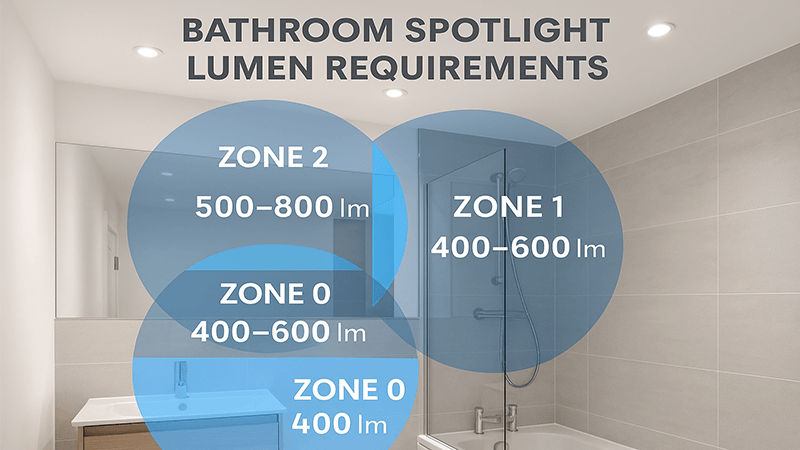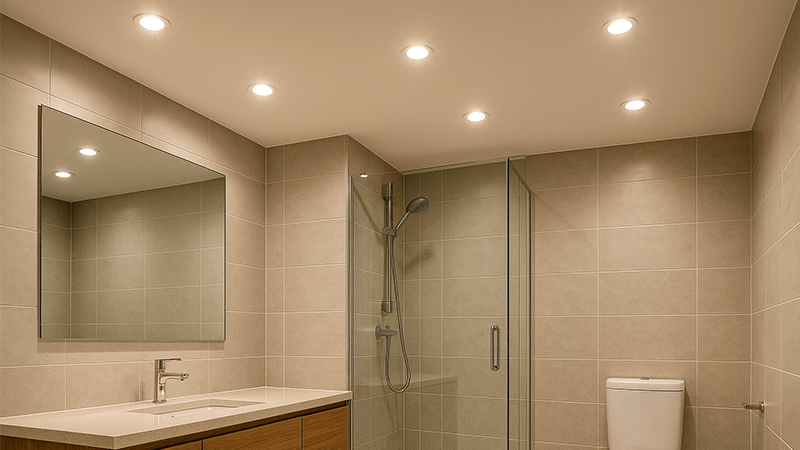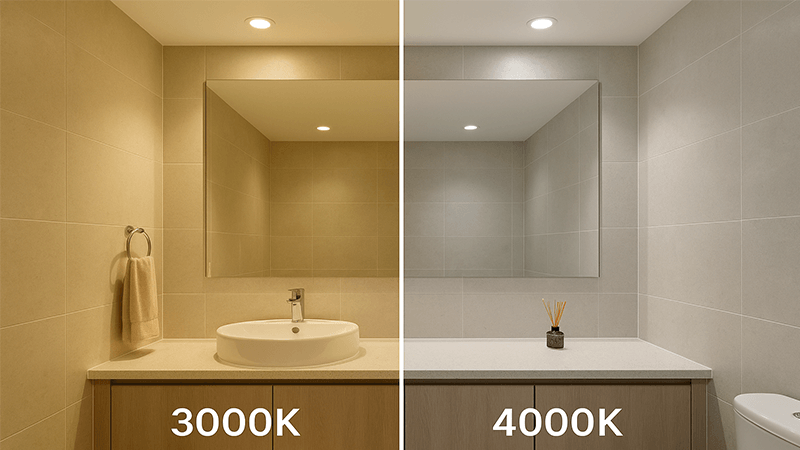Struggling with bathroom lighting that’s too dim or blindingly bright? This creates shadows and makes simple tasks difficult, leaving you frustrated every morning.
A good starting point is 500-600 lumens per square meter (or 50-60 lumens per square foot). For task areas like vanities, aim for at least 700-800 lumens. This ensures a bright, functional space without being harsh.

But as a lighting manufacturer, I can tell you that lumens are just one part of the story. Simply chasing a high number won’t guarantee good lighting. The right brightness depends on the room’s size, its specific functions, and even the color of the walls. Let’s break down how to choose the perfect lighting for any bathroom project so you can source with confidence.
Is 1500 lumens too bright for a bathroom?
Worried that installing a 1500-lumen spotlight will turn your client’s bathroom into an interrogation room? Overly bright light can feel clinical and uncomfortable, ruining a relaxing atmosphere.
For a single spotlight, 1500 lumens is often too bright for a small or average-sized bathroom. This much light is better suited for a very large bathroom or as the total combined output of multiple, dimmable spotlights spread across the room.

From my experience in the factory, I’ve seen many clients specify a high lumen count thinking "brighter is better." But a single 1500-lumen fixture can be a big mistake. It creates a harsh "hotspot" directly below it and leaves the corners of the room in shadow. This high contrast is straining on the eyes and very unflattering.
Instead of one powerful light, it’s much better to use a strategy of layered lighting. You can achieve a total output of 1500 lumens or more, but the result is far superior.
Breaking Down Lighting Layers
Layering involves using multiple light sources with different functions to create a balanced and flexible lighting scheme.
- Ambient Lighting: This is the general, overall illumination for the room. You can achieve this with several 400-600 lumen spotlights spaced evenly across the ceiling. For a standard 5 square meter bathroom, four 500-lumen spots would provide 2000 lumens of comfortable, even light.
- Task Lighting: This is focused, brighter light for specific tasks like shaving or applying makeup. Here, you need concentrated light at the vanity. This can be two wall sconces or a dedicated spotlight of 700-800 lumens.
- Accent Lighting: This is used to highlight architectural features or decor, like a textured wall or a piece of art. These are typically lower-lumen spotlights.
The Power of Dimmability
If a project absolutely requires a single high-lumen fixture, the non-negotiable solution is dimmability. A 1500-lumen dimmable spotlight offers flexibility. It can be turned up to full brightness for cleaning and then dimmed down to 20-30% for a relaxing bath. This control transforms a potentially harsh light into a versatile tool. As a purchaser, always check if a high-lumen fixture is compatible with leading-edge or trailing-edge dimmers.
Is 1200 lumens enough for a bathroom?
You’ve found a 1200-lumen option but are not sure if it will be sufficient. Under-lighting a bathroom can make it feel small and gloomy, and it’s a functional problem for users.
For a small to medium-sized bathroom (around 4-6 square meters), 1200 lumens can be perfectly adequate, especially if it’s the total output from 2-3 well-placed spotlights. For larger bathrooms, 1200 lumens would likely only be sufficient for one zone, not the entire space.

The effectiveness of 1200 lumens depends entirely on how it’s distributed. Let’s think like a lighting designer. A single 1200-lumen fixture will create the same "hotspot" problem we discussed earlier, though less severe than 1500 lumens. However, if you break that 1200 lumens into multiple sources, the story changes.
For example, using three 400-lumen spotlights provides a much more even and pleasant illumination across the entire room. This approach eliminates harsh shadows and creates a more professional and high-end feel.
Factors That Influence Brightness Needs
The lumen number on the box doesn’t exist in a vacuum. I always advise my clients to consider these factors before making a final decision on brightness.
- Wall & Ceiling Color: Dark tiles and paint absorb light. A bathroom with black or dark blue walls might need 20-30% more lumens to feel as bright as a white bathroom. Light-colored, glossy surfaces reflect light, making the space feel brighter with fewer lumens.
- Ceiling Height: Higher ceilings require more powerful or more numerous lights to deliver the same amount of light at floor level. For a 3-meter ceiling, you may need to increase your total lumen target by 10-20% compared to a standard 2.4-meter ceiling.
- User Preference: Some people simply prefer a brighter, more energizing space, while others want a softer, more spa-like environment. Dimmers are the best way to cater to all preferences.
Here is a quick reference table for a typical bathroom:
| Bathroom Size (sq. meters) |
Wall Color |
Recommended Total Lumens |
Suggested # of Spotlights (400-600 lm each) |
| 4 (Small) |
Light |
2000 – 2400 lm |
3-4 |
| 4 (Small) |
Dark |
2400 – 2800 lm |
4-5 |
| 8 (Medium) |
Light |
4000 – 4800 lm |
6-8 |
| 8 (Medium) |
Dark |
4800 – 5600 lm |
8-10 |
| 12+ (Large) |
Light |
6000 – 7200+ lm |
10+ |
As you can see, 1200 lumens is a good building block, but rarely the total solution.
Is 3000K or 4000K lighting better for bathrooms?
Choosing between color temperatures can be confusing. You want a color that is both functional for tasks and creates the right atmosphere, but the wrong choice can make a space feel off.
For most residential bathrooms, 3000K (Warm White) is the preferred choice. It creates a relaxing, welcoming atmosphere. 4000K (Cool White) is excellent for commercial or modern bathrooms where a cleaner, more energizing and clinical look is desired.

This is one of the most common questions I get from partners like Shaz. The choice between 3000K and 4000K is about setting the right mood and ensuring functionality. There’s no single "best" answer, as it depends on the design intent of the space.
3000K: The Spa-Like Choice
- Atmosphere: 3000K light has a slightly yellowish tone, similar to an early morning sun. It’s warm, inviting, and relaxing. This is why it’s the standard for homes and hotels aiming for a comfortable, spa-like feel.
- Functionality: It’s perfectly functional for general tasks. It renders skin tones in a warm, flattering way. Most people are used to this color temperature in their homes, so it feels natural.
- Best For: Master bathrooms, guest bathrooms, powder rooms, and any residential project where comfort is the top priority. It pairs well with warm materials like wood, brass, and natural stone.
4000K: The Crisp & Clean Choice
- Atmosphere: 4000K light is more neutral, with a slight blueish tint. It feels crisp, clean, and energizing, similar to daylight on an overcast day. This is why it’s popular in commercial spaces like office restrooms or gyms.
- Functionality: This color temperature is excellent for task-oriented areas. It provides high contrast, which can be helpful for detailed tasks like applying makeup or shaving. It makes whites look whiter and gives a space a very modern, clean aesthetic.
- Best For: Modern and minimalist bathroom designs, commercial restrooms, or for clients who specifically want a bright, daylight-like feel in their home. It pairs well with chrome, pure white tiles, and cool-toned decor.
When sourcing, it’s wise to stock both options or choose products with selectable color temperatures to meet diverse project needs.
Is 5000K or 6000K better for bathrooms?
Sometimes a project calls for very bright, daylight-like light. But going too high on the Kelvin scale can create an unpleasant, even sterile environment.
Neither 5000K nor 6000K is generally recommended for residential bathrooms. This light is very blue and harsh, creating a clinical or industrial feel. It can also make skin tones appear pale and unhealthy, which is not ideal for a vanity area.

As a manufacturer, I strongly caution against using 5000K or higher in a residential bathroom setting. This range of color temperature is what we call "Full Daylight" or "Cool Daylight." It’s an intensely blue-white light that mimics bright, direct noon sunlight. While it sounds good in theory, in a small, enclosed space like a bathroom, it feels sterile and uncomfortable.
The Problem with High Kelvin Light in Bathrooms
The biggest issue is how it renders color, especially skin tones.
- Poor Color Rendition for People: Under 5000K-6000K light, skin looks washed out and pale. Any redness or blemishes are exaggerated. When someone applies makeup in this light, they will likely overcompensate. When they go outside or into a normally lit room, their makeup will look heavy and unnatural.
- Sterile Atmosphere: This color temperature is often used in hospitals, warehouses, and laboratories for a reason—it promotes alertness and high visibility for clinical tasks. In a home, it destroys any sense of relaxation or comfort.
- The "Cheap LED" Look: This brings me to a critical point I share with all my partners. Many low-cost LED manufacturers chase high lumen numbers at a low price. One easy way to do this is by using chips with a high color temperature (5000K+) and sacrificing color rendering quality. Specifically, they cut out the red spectrum (known as R9). A light with poor R9 makes reds look dull and brown. For skin tones and makeup, this is a disaster.
A quality light source should have a Color Rendering Index (CRI) above 90 and, crucially, an R9 value above 50. High-end lighting now even uses the TM-30 standard for a more complete picture of color fidelity. When you’re sourcing, asking a supplier for the R9 or TM-30 data separates the quality manufacturers from the rest. For bathrooms, a CRI 90+, R9 > 50 light at 3000K or 4000K is the professional standard.
Conclusion
Choosing the right bathroom spotlight involves balancing lumens, color temperature, and layout. Prioritize quality CRI and layering lights over a single, high-lumen fixture for the best results.